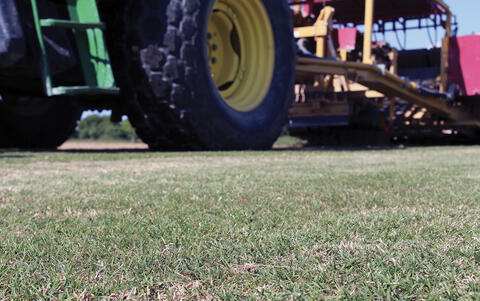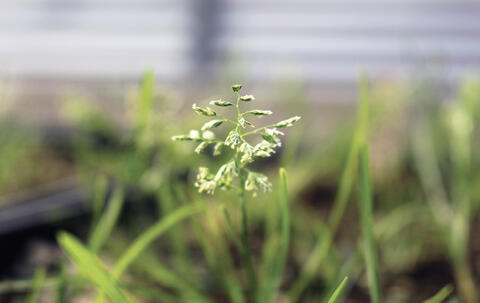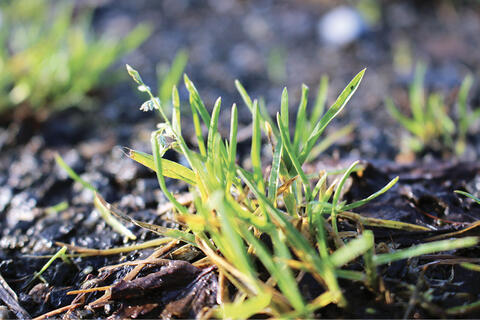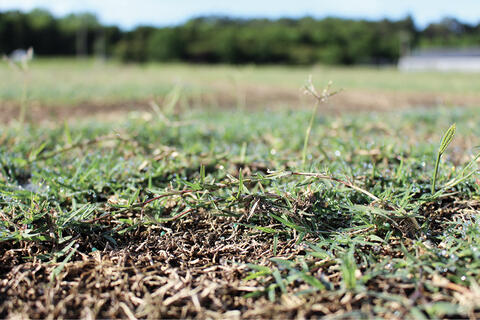P2986
Annual Bluegrass Control in Mississippi Sod Production

Annual bluegrass (Poa annua) is a troublesome annual weed in both warm- and cool-season grasses, whether home lawns, sports fields, golf courses, or sod farms. However, sod production practices tend to promote annual bluegrass as a weed with limited chemical-control options. Some main causes of annual bluegrass proliferation on sod farms include repeatedly leaving barren soil fallow and using sprigging stock and harvesting and maintenance equipment contaminated with the weed.
Annual bluegrass emerges from seed in the late summer and early fall when soil temperatures drop below approximately 70 degrees. The weed produces seed throughout the following winter, spring, and early summer. Preventing annual bluegrass emergence and success on Mississippi sod farms requires an integrated approach. Cultural practices, such as using clean foundation sprigs and limiting introduction and spread of seed on equipment, are important but are not guarantees of success.
Due to the size of most sod farms, successful control requires a combined approach with cultural methods plus herbicides. Herbicides can be broken into three categories: (1) preemergence, (2) postemergence, and (3) chemicals with both preemergence and postemergence activity (Table 1). Preemergence herbicides are applied before annual bluegrass germination.
Dates for annual bluegrass germination range considerably from year to year; however, standard preemergence applications are made as early as August 15 in northern Mississippi and as late as October 1 on the coast. In most cases, it is better to apply early rather than late. Late applications should contain a preemergence herbicide in combination with a postemergence herbicide or should use a product with preemergence and postemergence activity.
Postemergence herbicide applications are applied when weather cooperates in the fall through early spring. This approach may be expensive and jeopardize recovery from winter dormancy. Because these herbicides are applied after emergence of weed seedlings, they control only emerged weeds. If you use selective herbicides (herbicides safe to the sod), you can make applications that effectively control bluegrass plants before seed production. Only when turfgrass is fully dormant should you apply nonselective herbicides (glyphosate or other herbicides that may injure sod). This approach often fails to prevent seed dispersal and contamination of the following year’s crop.
This publication reviews common sod-production herbicide options so that sod producers can make appropriate choices to limit emergence and success of annual bluegrass.

Fundamental Considerations for Sod Producers
- Herbicide selection for warm- and cool-season sod production differs. For more information about herbicide safety, consult with your Extension agent.
- Always read and follow label directions. Some products cannot be used in sod production at all. Others have restrictions on when sod can be harvested after their use.
- All preemergence herbicides inhibit root growth in some way, which is critical to sod production. Some are safer than others, but safety depends on the rate used. Commercial products typically have lower labeled rates intended for sprigged plantings or where sod is being regrown after harvest.
- Most preemergence herbicides can be applied to centipedegrass and St. Augustinegrass. However, these species rely upon stolon growth (above-ground stems) to a greater extent than either bermudagrass or zoysiagrass, which have both rhizomes and stolons. For this reason, preemergence-herbicide selection should be made based upon prior experience and/or discussion with an Extension agent.
- The effects of fall preemergence herbicides on sod tensile strength are not well understood, and the long list of preemergence herbicides has not been researched extensively. Spring applications may be more likely than fall applications to inhibit the best timing for warm-season sod growth, ultimately leading to decreased sod strength. However, you should be careful any time you apply preemergence herbicides to very young sprigs and plugs.
- Preemergence herbicides typically lack postemergence control, but there are exceptions. Pre/post herbicides, like those discussed later, allow for control of already-germinated weeds. Postemergence herbicides may also be applied in combination with preemergence herbicides in order to “reach back” and control previously germinated weeds while also providing “residual” control of weeds that have not germinated yet.
- In high-end turf production, many experts recommend splitting preemergence applications roughly 8 weeks apart (approximately August or September followed by October or November applications in Mississippi). Due to the size and scale of most sod farms, a single application is more reasonable and can be very effective when appropriately timed or combined with a postemergence herbicide program.
- A fall/winter (October through February) selective herbicide application, such as atrazine, simazine, Kerb, Monument, Revolver, TranXit, or Negate, is commonly applied where sod hasn’t reached true dormancy.
- A winter (January or February) nonselective herbicide, such as Roundup or Finale, may be applied after sod is truly dormant and forecasted temperatures prolong dormancy. Producers generally should not use these nonselective options on centipedegrass and St. Augustinegrass. This application is sometimes combined with a preemergence herbicide intended to prevent spring-germinating weeds, such as crabgrass and goosegrass.
“True Preemergence” Options
- dithiopyr (Dimension 2EW, Dithiopyr 2L, Dithiopyr WSB)
- oryzalin (Surflan, Oryzalin 4 Pro, etc.)
- pendimethalin (Pendulum Aqua Cap, Pendulum 3.3EC, Pre-M)
- prodiamine (Barricade 4L, Prodiamine 65WG, Resolute)
- trifluralin (Treflan)
Prodiamine, pendimethalin, oryzalin, and trifluralin are dinitroaniline herbicides, while dithiopyr is a pyridine herbicide. Despite being in separate chemical classes, these herbicides have a similar effect: They inhibit cell division in young roots of developing plants. Read and follow label directions and suggested rates. In some instances, labels prohibit use of these and other products as much as 3 months before harvest.
- metolachlor (Pennant Magnum)
This option is often combined with simazine or atrazine for enhanced preemergence activity.
- oxadiazon (Ronstar WSP, Ronstar Flo, Ronstar G, Oxadiazon 50 WSB)
When applied as a liquid to nondormant turf, oxadiazon injures sod. However, when dry formulations are applied on a granular carrier, such as fertilizer or other inert particles, turf injury is minimal. If you apply it as a liquid, immediately remove the herbicide solution from green leaf tissue by heavy irrigation, or apply it before rainfall is forecast.
- indaziflam (Specticle)
Indaziflam, which inhibits cellulose biosynthesis, is labeled for use on bermudagrass, zoysiagrass, and centipedegrass. But it must not be applied before regrowth from ribbons reaches 80 percent cover or up to 4 months before harvest. Apply no sooner than 16 months after sprigging to allow for good stand establishment.

Pre and Post Control
- atrazine (Aatrex and others)
- simazine (Princep and others)
Atrazine and simazine work by inhibiting photosystem II (PSII) plant proteins. Annual bluegrass resistance to these and other PSII-inhibiting herbicides limits their effectiveness at most Mississippi sod farms (see Extension Publication 2844 Preventing and Managing Herbicide-Resistant Weeds in Turfgrass). However, these herbicides still have great value. Although they sometimes have limited activity on annual bluegrass, they are both pre- and postemergently active and typically control a broad spectrum of other broadleaf winter annuals. At labeled rates, they are considered safe postemergence herbicides for centipedegrass and St. Augustinegrass. Atrazine is a common addition to other herbicides applied in the fall. However, it can be particularly harmful to bermudagrass when applied as a liquid, especially during warmer growing months.
- flumioxazin (Sureguard, Panther)
Flumioxazin is similar to oxadiazon, except that it is sometimes used for postemergence burn-down of existing annual bluegrass and broadleaf weeds. When applied as a liquid to nondormant turf, flumioxazin injures sod. Dry formulations applied on a granular carrier may limit turf injury, but there are currently no commercially marketed granular products sold for turf.
- pronamide (Kerb)
Pronamide provides preemergence and early-postemergence control where resistance to simazine, dinitroanalines, and ALS-inhibiting herbicides (next section) is common. It is cost-prohibitive in some instances but is labeled for use in St. Augustinegrass, bermudagrass, centipedegrass, and zoysiagrass.
Selective “Postemergence Only”
With the exception of pre/post-active herbicides previously mentioned, postemergence herbicides for annual bluegrass control are limited to the same mode of action: They inhibit the acetolactate synthase (ALS) protein in plants.
- foramsulfuron (Revolver)
- rimsulfuron (Tranxit or Quali-Pro rimsulfuron 25 DF)
- rimsulfuron + metsulfuron (Quali-Pro Negate 37 WG)
- trifloxysulfuron (Monument)
- sulfosulfuron (Certainty)
- flazasulfuron (Katana)
Products detailed here are not labeled for application to centipedegrass or St. Augustinegrass. Since these chemicals use the same mode of action, weeds are likely to develop herbicide resistance. In fact, there are already reports of many resistant annual bluegrass populations throughout the state and Southeast. Rotation between preemergence and postemergence herbicides, as well as rotation between herbicides with different modes of action, is critical to the continued viability of these herbicides. Adequate spray volumes (20–40 gallons per acre) will increase effectiveness. Many postemergence products require an added surfactant or oil to help them enter the plant foliage.
The ALS inhibitors sometimes have slight preemergence activity on annual bluegrass. This action is a consequence of their soil activity. These herbicides are often absorbed by roots and leaves. They do not have true preemergence activity like many of the previously mentioned preemergence and pre/post herbicides, but they often have very short-term residual activity if conditions are favorable.

Nonselective Poa annua Control
Nonselective options are viable if warm-season turfgrass is dormant. Applications to green turf can be harmful, but you may use them if you’re willing to accept slowed regrowth and recovery. Use of nonselective herbicides is not recommended on centipede or St. Augustine grasses.
- glyphosate (Roundup)
Applications of glyphosate are warranted only for nonselective control within the northern transition area or where slowed growth is acceptable. Resistance to glyphosate is on the rise, so rotating to other nonselectives, as well as fall preemergence and selective winter postemergence control, are crucial to the continued viability of this product. Low-volume applications (less than 15 gallons per acre) may help reduce potential for turf injury. A high-volume application may rehydrate desiccated growing plant tissue, ultimately increasing herbicide uptake by the desired turf. Adequate spray coverage and droplet size is still important for weed control.
- diquat (Reward)
Diquat applications may be effective on immature plants. Applications are nonselective and may significantly affect turf health.
- glufosinate (Finale)
This herbicide is an option when rotating modes of action of postemergence winter applications. Glufosinate kills plants quickly and may compromise uptake of other systemic herbicides. Glufosinate is a postemergence option where glyphosate resistance is common. For additional information, see Extension Publication 1532 Weed Control Guidelines for Mississippi.

|
Timing |
Mode of Action |
WSSA Group |
HRAC Group |
Common Name |
Trade Name |
|---|---|---|---|---|---|
|
Pre |
Mitotic inhibition |
3 |
K1 |
dithiopyr |
Dimension |
|
Pre |
Cellulose synthesis inhibition |
29 |
L |
indaziflam |
Specticle |
|
Pre |
Very long chain fatty acid synthesis inhibition |
15 |
K3 |
metolachlor |
Pennant Magnum |
|
Pre |
Protoporphyrinogen oxidase (PPO) inhibition |
3 |
K1 |
oryzalin |
Surflan |
|
Pre |
Protoporphyrinogen oxidase (PPO) inhibition |
14 |
E |
oxadiazon |
Ronstar |
|
Pre |
Mitotic inhibition |
3 |
K1 |
pendimethalin |
Pendulum |
|
Pre |
Mitotic inhibition |
3 |
K1 |
prodiamine |
Barricade |
|
Pre |
Mitotic inhibition |
3 |
K1 |
trifluralin |
Barricade |
|
Pre/Post |
Photosystem II inhibition |
5 |
C1 |
atrazine |
Aatrex |
|
Pre/Post |
Protoporphyrinogen oxidase (PPO) inhibition |
14 |
E |
flumioxazin |
SureGuard |
|
Pre/Post |
Mitotic inhibition |
3 |
K1 |
pronamide |
Kerb |
|
Pre/Post |
Photosystem II inhibition |
5 |
C1 |
simazine |
Princep |
|
Post Selective |
Acetolactate synthase (ALS) inhibition |
2 |
B |
foramsulfuron |
Revolver |
|
Post Selective |
Acetolactate synthase (ALS) inhibition |
2 |
B |
rimsulfuron+metsulfuron |
Negate |
|
Post Selective |
Acetolactate synthase (ALS) inhibition |
2 |
B |
rimsulfuron |
TranXit |
|
Post Selective |
Acetolactate synthase (ALS) inhibition |
2 |
B |
sulfosulfuron |
Certainty |
|
Post Selective |
Acetolactate synthase (ALS) inhibition |
2 |
B |
trifloxysulfuron |
Monument |
|
Post Nonselective |
Enolpyruvyl Shikimate-3 Phosphate (EPSP) synthase inhibition |
9 |
G |
glyphosate |
Roundup |
|
Post Nonselective |
Glutamine synthetase inhibition |
10 |
H |
glufosinate |
Finale |
1Site of action is listed according to the Weed Science Society of America (WSSA) and the Herbicide Resistance Action Committee (HRAC).
References
J. T. Brosnan, G. K. Breeden, A. W. Thoms, and J. C. Sorochan. (2014) Effects of preemergence herbicides on the establishment rate and tensile strength of hybrid bermudagrass sod. Weed Technology 28: 206-212.
E. G. Begitschke, J. D. McCurdy, T. M. Tseng, T. C. Barickman, C. M. Baldwin, B. R. Stewart, M. P. Richard, and J. K. Ward. 2018. Preemergence herbicide effects upon hybrid bermudagrass sprigged establishment and sod tensile strength. Agronomy Journal 110(6): 2243-2249.
The information given here is for educational purposes only. References to commercial products, trade names, or suppliers are made with the understanding that no endorsement is implied and that no discrimination against other products or suppliers is intended.
Publication 2986 (POD-08-22)
By Jay McCurdy, PhD, Associate Professor, Plant and Soil Sciences.
